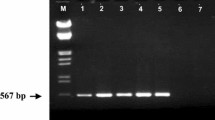Abstract
Since the late 1980s powdery mildew, designated Oidium lycopersicum, frequently invaded the tomato crop in Western Europe. All commercial cultivars are susceptible. To screen for resistance in wild species a reliable and efficient disease test was developed. Young plants with two to three true leaves are inoculated at high relative humidity by spraying with a freshly prepared suspension of 2×104 conidia, ml−1. Symptoms are periodically evaluated according to a scale based on the percentage of leaf area with mycelium.
One hundred and twenty seven accessions, representing eight wild Lycopersicon species, were screened for resistance to O. lycopersicum. A large variation in resistance was found between species. L. hirsutum was the most resistant species; L. pennellii was moderately resistant; species of the subgeneric group of L. esculentum and of the ‘peruvianum-complex’ were all susceptible. L. parviflorum was classified separately due to a large variation between accessions. Except for this species, a low variation was found between accessions within species. High levels of resistance were observed in four accessions of L. hirsutum, in one of L. parviflorum and in one of L. peruvianum. This resistance is characterized by a very low disease incidence and a strongly restricted mycelium growth and lack of sporulation.
Similar content being viewed by others
References
Blancard D., 1988. Maladies de la tomate. INRA, Paris.
Fletcher J.T., B.J. Smewin & R.T.A. Cook, 1988. Tomato powdery mildew. Plant Pathology 37: 594–598.
Forsberg A.S. 1989. Tomato powdery mildew—occurrence and control trials (Swedish). Växtskyddsnotiser 53: 144–148.
Gabler J., W. Gerlach & U. Braun, 1990. Epidemisches Auftreten eines echten Mehltaus an Tomaten in der DDR. Nachrichtenbl. Deut. Pflantzenschutzd. 42: 94–95.
Hirata K., 1966. Host range and geographical distribution of the powdery mildews. pp. 294–295. Faculty of Agriculture, Niigata University, Japan.
Lindhout P. & C. Purimahua, 1988. Use of L. peruvianum LA1708 and LA2172 as a bridge between L. esculentum and L. peruvianum. Tomato Genetics Cooperative Report 38: 29.
Lindhout, P. & C. Purimahua, 1992. Characterization of new resistance to Clavibacter michiganensis subsp. michiganensis in Lycopersicon peruvianum. Plant Disease (submitted).
Noordeloos M.E. & W.M. Loerakker, 1989. Studies in plant pathogenic fungi—II. On some powdery mildews (Erysiphales) recently recorded from the Netherlands. Persoonia 14: 51–69.
Paternotte S.J., 1988. Occurrence and chemical control of powdery mildew (Oidium sp.) in tomatoes. Med. Fac. Landbouww. Rijksuniv. Gent 53: 656–661.
Stevens M.A. & C.M. Rick, 1986. Genetics and breeding. In: J.G. Atherton & J. Rudisch (Eds.), The Tomato Crop, pp. 35–110. Chapman and Hall, London, New York.
Author information
Authors and Affiliations
Rights and permissions
About this article
Cite this article
Lindhout, P., Pet, G. & van der Beek, H. Screening wild Lycopersicon species for resistance to powdery mildew (Oidium lycoperiscum). Euphytica 72, 43–49 (1993). https://doi.org/10.1007/BF00023771
Received:
Accepted:
Issue Date:
DOI: https://doi.org/10.1007/BF00023771




